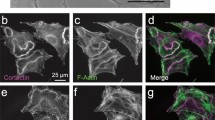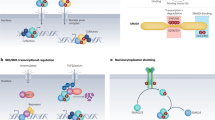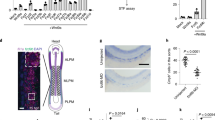Abstract
Growth factor signaling leads to the induction or repression of immediate early genes, but how these genes act collectively as effectors of downstream processes remains unresolved. We have used gene trap–coupled microarray analysis to identify and mutate multiple platelet-derived growth factor (PDGF) intermediate early genes in mice. Mutations in these genes lead to a high frequency of phenotypes that affect the same cell types and processes as those controlled by the PDGF pathway. We conclude that these genes form a network that controls specific processes downstream of PDGF signaling.
This is a preview of subscription content, access via your institution
Access options
Subscribe to this journal
Receive 12 print issues and online access
$209.00 per year
only $17.42 per issue
Buy this article
- Purchase on Springer Link
- Instant access to full article PDF
Prices may be subject to local taxes which are calculated during checkout







Similar content being viewed by others
References
Lau, L.F. & Nathans, D. Expression of a set of growth-related immediate early genes in BALB/c 3T3 cells: coordinate regulation with c-fos or c-myc. Proc. Natl. Acad. Sci. USA 84, 1182–1186 (1987).
Rollins, B.J. & Stiles, C.D. Serum-inducible genes. Adv. Cancer Res. 53, 1–32 (1989).
Marshall, C.J. Specificity of receptor tyrosine kinase signaling: transient versus sustained extracellular signal-regulated kinase activation. Cell 80, 179–185 (1995).
Simon, M.A. Receptor tyrosine kinases: specific outcomes from general signals. Cell 103, 13–15 (2000).
Bertotti, A. & Comoglio, P.M. Tyrosine kinase signal specificity: lessons from the HGF receptor. Trends Biochem. Sci. 28, 527–533 (2003).
Fambrough, D., McClure, K., Kazlauskas, A. & Lander, E.S. Diverse signaling pathways activated by growth factor receptors induce broadly overlapping, rather than independent, sets of genes. Cell 97, 727–741 (1999).
Freeman, M. Reiterative use of the EGF receptor triggers differentiation of all cell types in the Drosophila eye. Cell 87, 651–660 (1996).
Socolovsky, M., Fallon, A.E. & Lodish, H.F. The prolactin receptor rescues EpoR−/− erythroid progenitors and replaces EpoR in a synergistic interaction with c-kit. Blood 92, 1491–1496 (1998).
Klinghoffer, R.A., Mueting-Nelsen, P.F., Faerman, A., Shani, M. & Soriano, P. The two PDGF receptors maintain conserved signaling in vivo despite divergent embryological functions. Mol. Cell 7, 343–354 (2001).
Betsholtz, C., Karlsson, L. & Lindahl, P. Developmental roles of platelet-derived growth factors. Bioessays 23, 494–507 (2001).
Hoch, R. & Soriano, P. PDGF Roles in animal developement. Development 130, 4769–4784 (2003).
Soriano, P. The PDGF alpha receptor is required for neural crest cell development and for normal patterning of the somites. Development 124, 2691–2700 (1997).
Soriano, P. Abnormal kidney development and hematological disorders in PDGF beta-receptor mutant mice. Genes Dev. 8, 1888–1896 (1994).
Lindahl, P., Johansson, B.R., Leveen, P. & Betsholtz, C. Pericyte loss and microaneurysm formation in PDGF-B-deficient mice. Science 277, 242–245 (1997).
Hellström, M. et al. Lack of pericytes leads to endothelial hyperplasia and abnormal vascular morphogenesis. J. Cell Biol. 153, 543–553 (2001).
Lindahl, P. et al. Paracrine PDGF-B/PDGF-Rbeta signaling controls mesangial cell development in kidney glomeruli. Development 125, 3313–3322 (1998).
Chen, W.V., Delrow, J., Corrin, P.D., Frazier, J.P. & Soriano, P. Identification and validation of PDGF transcriptional targets by microarray-coupled gene-trap mutagenesis. Nat. Genet. 36, 304–312 (2004).
Bodnar, J.S. et al. Positional cloning of the combined hyperlipidemia gene Hyplip1. Nat. Genet. 30, 110–116 (2002).
Takemoto, M. et al. Large-scale identification of genes implicated in kidney glomerulus development and function. EMBO J. 25, 1160–1174 (2006).
Tallquist, M.D. & Soriano, P. Cell autonomous requirement for PDGFRalpha in populations of cranial and cardiac neural crest cells. Development 130, 507–518 (2003).
Klinghoffer, R.A., Hamilton, T.G., Hoch, R. & Soriano, P. An allelic series at the PDGFalphaR locus indicates unequal contributions of distinct signaling pathways during development. Dev. Cell 2, 103–113 (2002).
Grüneberg, H. & Truslove, G.M. Two closely linked genes in the mouse. Genet. Res. Camb. 1, 69–90 (1960).
Pawson, T. & Saxton, T.M. Signaling networks–do all roads lead to the same genes? Cell 97, 675–678 (1999).
Kuo, C.T. et al. The LKLF transcription factor is required for normal tunica media formation and blood vessel stabilization during murine embryogenesis. Genes Dev. 11, 2996–3006 (1997).
Hoch, R.V. & Soriano, P. Context-specific requirements for Fgfr1 signaling through Frs2 and Frs3 during mouse development. Development 133, 663–673 (2006).
Kuhlbrodt, K., Herbarth, B., Sock, E., Hermans-Borgmeyer, I. & Wegner, M. Sox10, a novel transcriptional modulator in glial cells. J. Neurosci. 18, 237–250 (1998).
El Mezgueldi, M., Tang, N., Rosenfeld, S.S. & Ostap, E.M. The kinetic mechanism of Myo1e (human myosin-IC). J. Biol. Chem. 277, 21514–21521 (2002).
Goutebroze, L., Brault, E., Muchardt, C., Camonis, J. & Thomas, G. Cloning and characterization of SCHIP-1, a novel protein interacting specifically with spliced isoforms and naturally occurring mutant NF2 proteins. Mol. Cell. Biol. 20, 1699–1712 (2000).
Zhou, J. & Saba, J.D. Identification of the first mammalian sphingosine phosphate lyase gene and its functional expression in yeast. Biochem. Biophys. Res. Commun. 242, 502–507 (1998).
Ame, J.C., Spenlehauer, C. & de Murcia, G. The PARP superfamily. Bioessays 26, 882–893 (2004).
Ishiguro, H. et al. Identification of AXUD1, a novel human gene induced by AXIN1 and its reduced expression in human carcinomas of the lung, liver, colon and kidney. Oncogene 20, 5062–5066 (2001).
Lemmon, M.A., Ferguson, K.M. & Abrams, C.S. Pleckstrin homology domains and the cytoskeleton. FEBS Lett. 513, 71–76 (2002).
Acknowledgements
We thank P. Corrin and M. Grenley for excellent technical assistance; B. Hoplight for assistance with statistical analysis and our laboratory colleagues S. Parkhurst and M. Van Gilst for critical reading of the manuscript. The Sox10 probe was a gift of M. Wegner (Universität Erlangen). J.S. and C.S.R. were the recipients of postdoctoral fellowships from the US National Institute of General Medical Sciences (GM071158) and from the Leukemia and Lymphoma Society, respectively, and both were supported by a Chromosome and Metabolism Training Grant (CA09657). This work was supported by grant HD24875 from the National Institute of Child Health and Human Development to P.S.
Author information
Authors and Affiliations
Contributions
J.S. and P.S. conceived and designed the experiments, P.S. generated chimeras and determined viability of mutant strains, C.S.R. focused on Sgpl1−/− mice, J.S. performed characterization of all the strains and analyzed the data and J.S. and P.S. wrote the paper.
Corresponding author
Ethics declarations
Competing interests
The authors declare no competing financial interests.
Supplementary information
Supplementary Fig. 1
Identification and verification of the insertion sites of the gene trap construct. (PDF 319 kb)
Supplementary Fig. 2
PDGF target genes are expressed in PDGF-dependent tissues. (PDF 305 kb)
Supplementary Fig. 3
Expression of PDGF target genes is altered in PDGFRβ−/− embryos. (PDF 223 kb)
Supplementary Table 1
Gene identification and insertion site. (PDF 92 kb)
Supplementary Table 2
Viability is reduced in mice with mutations in PDGF target genes. (PDF 95 kb)
Supplementary Table 3
Penetrance of skeletal defects in affected bones. (PDF 53 kb)
Supplementary Table 4
Primers used for genotyping mutant mice, for RT-PCR and for semiquantitative PCR. (PDF 60 kb)
Rights and permissions
About this article
Cite this article
Schmahl, J., Raymond, C. & Soriano, P. PDGF signaling specificity is mediated through multiple immediate early genes. Nat Genet 39, 52–60 (2007). https://doi.org/10.1038/ng1922
Received:
Accepted:
Published:
Issue Date:
DOI: https://doi.org/10.1038/ng1922
This article is cited by
-
Age-dependent Pdgfrβ signaling drives adipocyte progenitor dysfunction to alter the beige adipogenic niche in male mice
Nature Communications (2023)
-
Characterisation of PDGF-BB:PDGFRβ signalling pathways in human brain pericytes: evidence of disruption in Alzheimer’s disease
Communications Biology (2022)
-
Genotype/Phenotype Interactions and First Steps Toward Targeted Therapy for Sphingosine Phosphate Lyase Insufficiency Syndrome
Cell Biochemistry and Biophysics (2021)
-
Preclinical and Clinical Evidence for the Involvement of Sphingosine 1-Phosphate Signaling in the Pathophysiology of Vascular Cognitive Impairment
NeuroMolecular Medicine (2021)
-
Engineering combinatorial and dynamic decoders using synthetic immediate-early genes
Communications Biology (2020)



